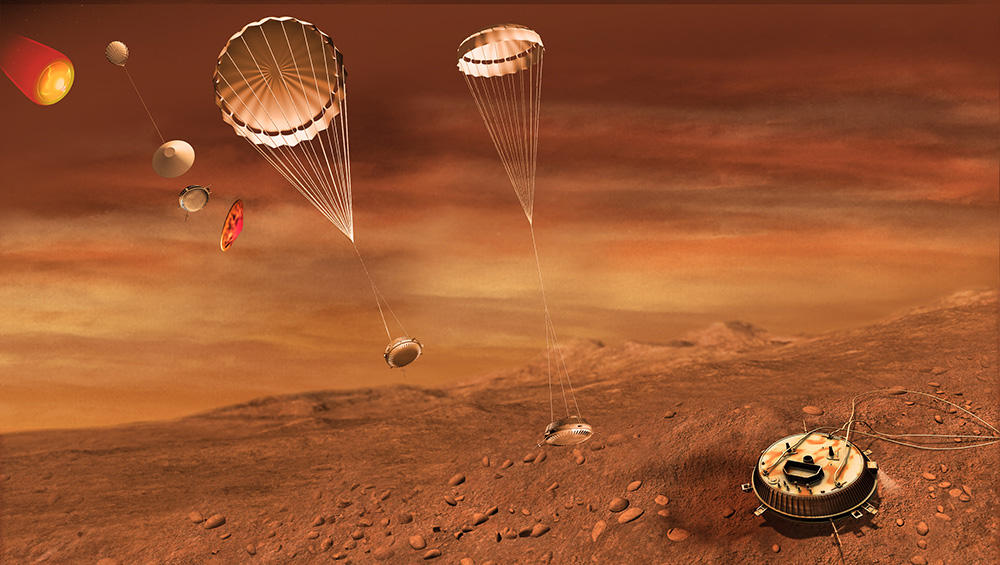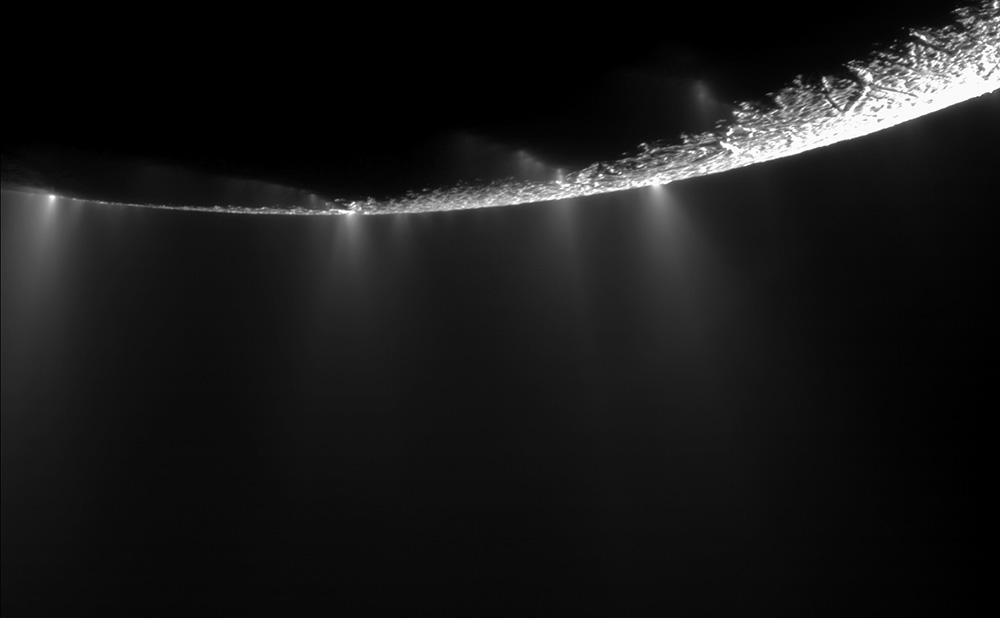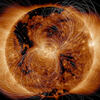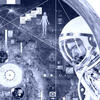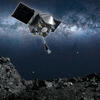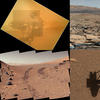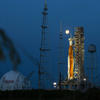You are here
Cassini's Grand Finale
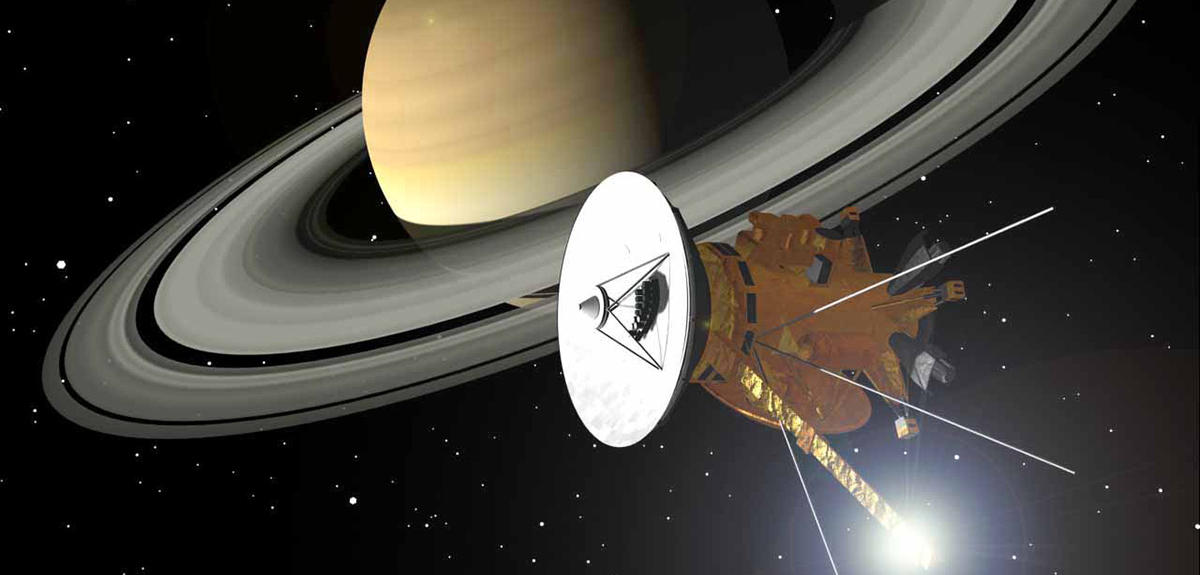
It has revolutionized what we know about Saturn and raised new questions about the Solar System. The Cassini-Huygens mission by NASA, the European Space Agency (ESA) and the Italian Space Agency (ASI) came to an end. On September 15, at 10:31 am UTC, the spacecraft, set four days earlier on its final trajectory, entered the upper layers of the giant planet's atmosphere, at an altitude of 1 920 km above the cloud tops.1 As it descended, it used its thrusters to attempt to keep its antenna pointed towards Earth for as long as possible. In the one to two minutes it took to drop 420 km, it sent back information about gas and plasma composition, temperatures and the magnetic field in the environments it encounters. It then suddenly ceased transmission and broke up under the combined effect of the heavy turbulence and tremendous heat produced as it plunges through Saturn's atmosphere at 111,000 km/h. Cassini's odyssey was over.
The mission's final radio signal, which took 83 minutes to travel from Saturn to Earth, would not arrive until 11:55 UTC. At that time, astronomers the world over no doubt felt a twinge of sadness, as this extraordinary adventure 1.43 billion kilometers from our planet came to an end.
A technical and human feat
Cassini was indeed unique. Firstly, because of its duration: developed in 1982 and launched in 1997, the spacecraft arrived in the region of Saturn in 2004, after a long voyage through the Solar System that included flybys of Venus (twice), Earth and Jupiter. Although its mission there was initially due to last four years, it was extended twice to reach a total of thirteen years, enabling scientists to observe Saturn and its moon Titan for two entire seasons of Saturn's year (which lasts 29 Earth years).
The mission was also remarkable from a technological and human perspective. Cassini-Huygens tested a method for saving fuel that had only previously been tried out by NASA during Galileo's mission to Jupiter. This involved using Titan's gravitational attraction to make orbital changes. By modifying its speed on each of its 127 flybys of the moon, the spacecraft was able to travel around the Saturn system for far longer than originally planned.
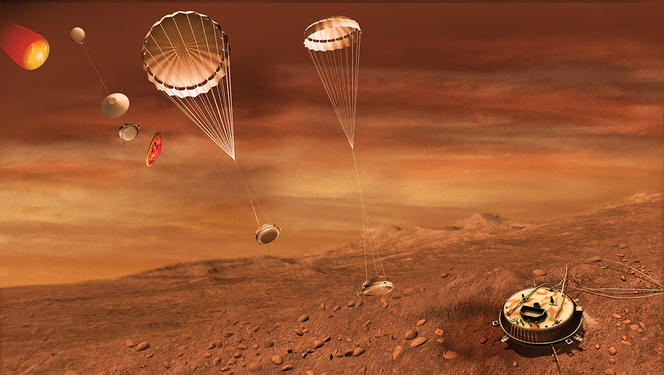
The program also saw the most distant landing ever achieved, and the first in the outer Solar System, when ESA's Huygens probe touched down on Titan on 14 January 2005. This was a scientific feat that enabled astronomers to obtain the first-ever images of the moon's surface, and a technical achievement that was all the more remarkable since "Huygens was not initially designed to land on Titan but only to carry out a descent into its atmosphere," recalls Athena Coustenis, a CNRS senior researcher at the LESIA2 involved in the mission from its inception.
19 participating countries, 4000 publications
In addition, there was exceptional international collaboration around the mission, which brought together three space agencies representing 19 countries. Data from the 18 science instruments on board the spacecraft (12 on Cassini and six on Huygens) were analyzed by thousands of researchers from 26 countries, while its construction involved dozens of teams, several of which from the CNRS. Having taken part in developing some of the spacecraft's systems, the French research organization was entrusted with significant responsibilities. Three of its members, Daniel Gautier, François Raulin and Michel Blanc, were appointed as Inter-Disciplinary Scientists (IDS). Another two, Guy Israël and Marcello Fulchignoni, were Principal Investigators (PIs) for the ACP and HASI instruments on Huygens, while around a dozen more were selected as Co-Investigators.
Most importantly, the Cassini-Huygens mission will stand out in the history of space exploration due to its groundbreaking discoveries, which by 29 August 2017 had resulted in 3948 scientific publications, according to a NASA estimate. These findings were so numerous and sometimes so unexpected that they helped not only transform existing knowledge of Saturn and its 62 moons (six of which were discovered by Cassini), but "also radically changed astronomers' view of the Solar System in general," Coustenis believes.
Mysterious Titan no more
The detailed observation of Titan led to some huge surprises. "Until 2004, specialists knew very little about Saturn's largest moon (diameter 5100 km), which had only been subject to one flyby, in 1980, by the Voyager 1 spacecraft," says Raulin, a researcher at the LISA3 and IDS for Cassini-Huygens. The nature of its surface, hidden under the opaque orange haze that shrouds the moon, was a mystery. In fact, the engineers feared that Huygens might even end up engulfed in an ocean or in marshes when it landed. Thanks to the information collected by the probe, as well as the 127 flybys of the moon subsequently carried out by Cassini, Titan has given up some of its secrets. We now know its temperature, as well as the composition of its atmosphere, which, like Earth's, is predominantly made up of nitrogen (96%), and is also rich in methane. To the researchers' surprise, the presence of organic ions was detected in its ionosphere, at an altitude of 1000 km. "A large part of its surface has been characterized, revealing unsuspected diversity," Raulin adds.
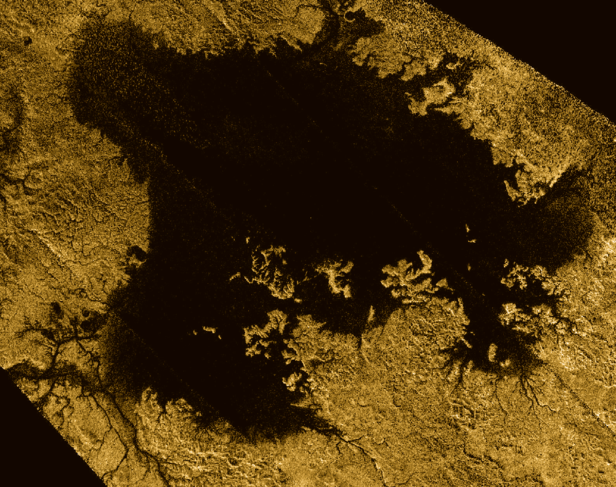


There are mountains, craters (although not many, indicating a geologically young surface), possible traces of cryovolcanism, dune fields of an as yet unknown nature in the equatorial regions, and in the northern part, two hundred lakes and a sea fed by river networks in which liquid methane and ethane flow.
The data collected over two entire seasons on Titan (during which astronomers observed changes in cloud cover, decreasing at the north pole and increasing at the south pole) has shown that—while Titan is very different from Earth as far as its materials are concerned—its geophysical properties are incredibly similar to our own planet's. A methane cycle shapes the landscape and controls the climate, which bear a strange resemblance to those on Earth, itself governed by the water cycle. As Stéphane Le Mouélic, a research engineer at LPG Nantes4 involved in Cassini's VIMS instrument, points out, "Titan, just like Earth, has expanses of liquid directly exposed to the atmosphere," making it the only other place in the Solar System displaying this phenomenon.
Enceladus, a habitable moon?
With Enceladus, the possibility of finding life elsewhere in the Universe lies at the heart of the Cassini-Huygens mission. Until it got there, this small moon of Saturn, only 500 km in diameter, was thought to be a geologically dead body. No specialist would have dared suggest that it might exhibit any trace of activity. However, in 2005, Cassini detected huge plumes of water vapor and ice grains erupting from the surface in a highly fractured region at the south pole. After a total of 23 flybys by the spacecraft, the scientists concluded that the jets, which are several hundred kilometers high, are likely to be caused by fluid shooting out from an internal ocean beneath the icy surface, where processes similar to those found on Earth at hydrothermal vents on mid-ocean ridges may be taking place. This came as a huge surprise since, at that time, the only body in the Solar System known to have an internal ocean was Jupiter's moon Europa, which is nearer the Sun. In 2012, astronomers had already shown that Titan might also have an underground ocean of this kind. As a result, the very notion of a "habitability zone"—in other words a region in a solar system where water can exist in a liquid state at the surface of or inside celestial bodies—was called into question by the Cassini-Huygens mission.
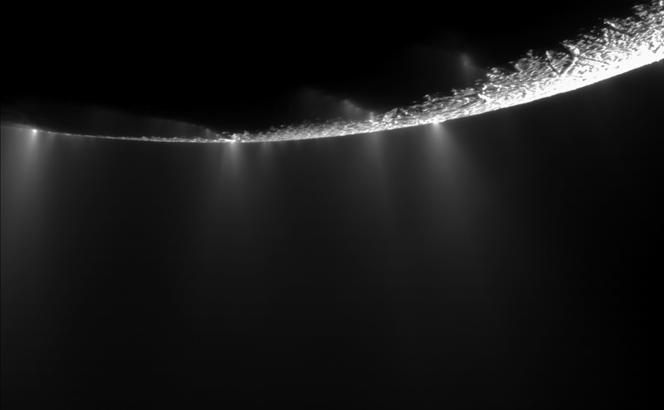
The rings: a multicolored vynil record
The project also shed fresh light on Saturn's unique ring system. Images of the rings sent back by the spacecraft look somewhat like a vinyl record colored grey, ivory, blue, red and black, in which four regions can easily be distinguished (the A, B and C rings, and the Cassini Division). Made up of a multitude of ice particles ranging in size from one millimeter to ten meters, they are thought to be composed of 99% water ice, although some astronomers disagree and believe that they conceal significant amounts of silicates, iron and organic compounds.
One of Cassini's main contributions was to demonstrate the role played by Saturn's moons in the composition and dynamics of the rings. The mission has shown that the ice ejected into space by the jets on Enceladus eventually ended up producing the outermost E ring, and that the motion of the moon Prometheus along its orbit explains the undulations that travel along the surface of the F ring. Observation of regions of the disc further in has also shown that some of the gaps in the rings are caused by the presence of small moons such as Pan, whose motion plows a furrow, sweeping the gaps clear of material. The size of the particles making up the rings is variable. In the A and B regions, a few are mountain-sized, reaching several thousand meters.


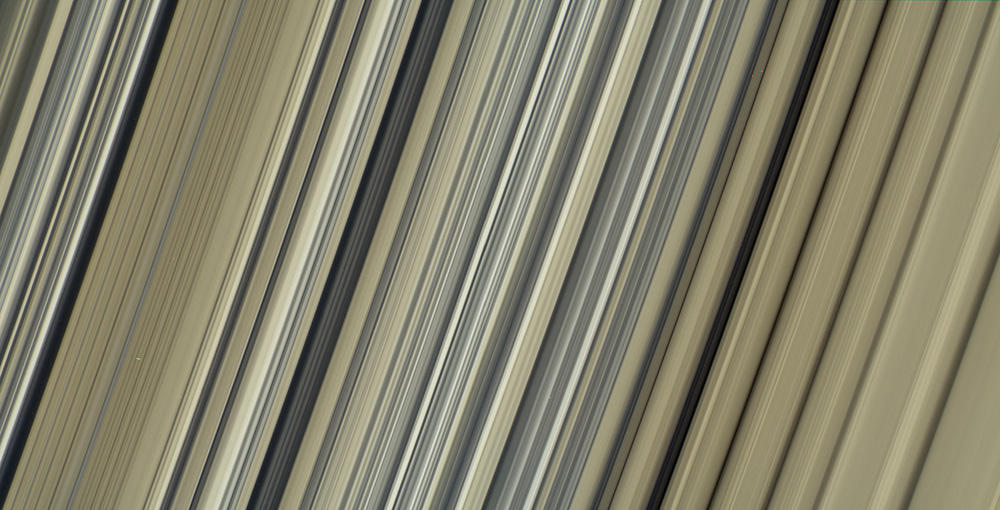
Yet the most exciting discoveries are probably still to come. One of the objectives of the very last phase of the mission, which began on 22 April and is dubbed the "Grand Finale," was to attempt to evaluate the mass of the rings from the gravity data collected during a series of 22 dives between Saturn and its innermost rings. This information will enable astronomers to determine which of the various scenarios explaining the origin of the rings is correct.
But in any case, "the Saturn system's giant planet, as well as its moons that interact with its rings, providing them with material and disrupting them, has already become a laboratory where astronomers can study certain key dynamic processes that take place on larger scales," points out Jean-Pierre Bibring, an astrophysicist at the IAS5 involved in the development of the VIMS instrument. "In particular, those that lead to the formation and evolution of planetary systems, in all their diversity."
Finally, the 453,048 images and 635 GB of data collected by Cassini-Huygens, have cast light on Saturn itself. With a grandstand view of the ringed planet over the past thirteen years, the spacecraft has observed how its climate changes with the seasons. It has witnessed the development and termination of a huge storm at the equinox. And it has taken unprecedented pictures of the well-known hexagonal cloud pattern that permanently occupies Saturn's northern high latitudes.
Cassini's grand finale was an ideal opportunity to take things further. This final phase of the mission for the first time provided in situ data about the planet's atmospheric composition. It also accurately mapped its gravitational field with the aim of estimating the size of the planet's hypothetical core, as well as determining whether the bands of belts and zones seen at the surface extend down to great depths. This information may even help researchers to find out why Saturn is the only planet in the Solar System whose magnetic field is aligned with its axis of rotation. This puzzling phenomenon is probably the reason why astronomers find it so difficult to measure the length of a Saturn day, which in recorded data seems to vary by around 1 hour 45 minutes. By measuring the planet's magnetic field very accurately, together with its radio emissions, the mission should be able to provide some answers. In any case, even if it has now reached the end of its life, Cassini-Huygens has no doubt collected enough data to keep astronomers busy for many years to come.
- 1. Since Saturn is a gas planet, it has no solid surface. Altitudes are measured from the cloud tops, where pressure is thought to be one bar.
- 2. Laboratoire d'Etudes Spatiales et d'Instrumentation en Astrophysique (CNRS / Observatoire de Paris / UPMC / Université Paris-Diderot). Athena Coustenis is involved in Huygens' HASI and DISR instruments, and in Cassini's CIRS and VIMS instruments.
- 3. Laboratoire Interuniversitaire des Systèmes Atmosphériques (CNRS / Université Paris-Est Créteil / Université Paris Diderot / Institut Pierre Simon Laplace). François Raulin is involved in Huygens' ACP and GCMS instruments and Cassini's CISR instrument.
- 4. Laboratoire de Planétologie et Géodynamique (CNRS / Université de Nantes / Université d'Angers / OSUNA).
- 5. Institut d'Astrophysique Spatiale (CNRS / Université Paris Sud 11).


